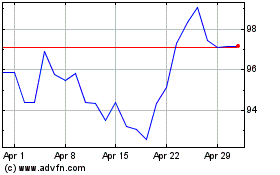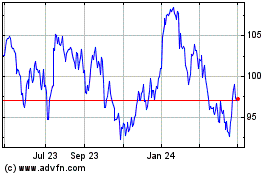By Peter Loftus
The U.S. Food and Drug Administration approved a new drug for
sickle cell disease Monday, adding to a new wave of treatments that
promise relief from the life-threatening blood disorder that
largely afflicts African-Americans.
Oxbryta, a once-daily pill from Global Blood Therapeutics Inc.,
blocks a process in blood cells that can lead to anemia and organ
damage, hallmarks of sickle cell disease. It is the second
treatment to get FDA approval in recent weeks, after the agency
approved Novartis AG's Adakveo to reduce the frequency of bouts of
pain that sickle cell patients can suffer.
Doctors say the new drugs have the potential to ease the
complications of sickle cell disease, which afflicts about 100,000
Americans.
More new treatments are on the horizon. Drugmakers including
Bluebird Bio Inc., Vertex Pharmaceuticals Inc. and Crispr
Therapeutics Inc., along with government researchers, are
developing experimental therapies that may have potential to cure
or provide long periods of relief.
"Everybody's been waiting for this moment where the flood gate
of new treatments is opening," said Dr. Biree Andemariam, chief
medical officer of the Sickle Cell Disease Association of America
and a sickle cell specialist at UConn Health, in Farmington,
Conn.
But the therapies are expensive, part of a growing trend of high
prices for drugs that treat rare diseases. Global Blood
Therapeutics priced Oxbryta at $125,000 a year, though the company
said the drug would cost most health plans $96,000 a year after
discounts. Novartis's drug lists for as much as $113,100 a year,
depending on the weight of the patient.
Drugmakers say the treatments can help cut other costs, such as
hospitalization.
Sickle cell disease is caused by an inherited mutation in an
oxygen-carrying protein known as hemoglobin. Decades ago, most
children diagnosed with it didn't live into adulthood. Life
expectancy has risen significantly since the 1980s, due to newborn
screening and treatment advances like blood transfusions and
penicillin to prevent severe infections.
But most patients don't live longer than 50 years, doctors say,
and many face debilitating complications including strokes and
kidney failure. Few drugs have been approved in recent decades.
Global Blood Therapeutics, of South San Francisco, Calif.,
designed Oxbryta to stop a molecular process that results in
sickle-shaped red blood cells, the feature that gives the disease
its name.
After 24 weeks of treatment, about 51% of the clinical-trial
subjects who had received a high dose of the drug had higher levels
of hemoglobin, the protein that carries oxygen in the blood,
compared with 33% among those getting a lower dose and 7% in the
placebo group. Those taking the drug also experienced reduced
anemia.
"We think what this drug is doing is fundamental in terms of
reversing disease," said Global Blood Therapeutics Chief Executive
Ted Love.
Reported side effects include headaches and diarrhea.
The FDA approved the drug's use in patients aged 12 years and
older.
"Our scientific investments have brought us to a point where we
have many more tools available in the battle against sickle cell
disease, which presents daily challenges for those living with it,"
said Acting FDA Commissioner Adm. Brett P. Giroir said.
Patricia Rose, 52, of Berwyn, Ill., said she took Oxbryta in a
clinical trial along with another drug called hydroxyurea she has
been taking since around 2000, and the combination helped alleviate
the painful episodes resulting from the disease more than the older
drug alone.
Novartis's Adakveo, infused intravenously once a month, was
approved in patients age 16 and older to reduce the frequency of a
painful complication of sickle cell that occurs when blood
circulation becomes obstructed. The pain often sends patients to
the hospital.
In a nearly 200-patient study, people taking Adakveo had a
median of 1.63 such episodes a year, versus 2.98 in the placebo
group.
Bluebird Bio is developing a gene therapy that would deliver
functional copies of the faulty gene that causes sickle cell
disease and restore a patient's ability to make healthy red-blood
cells. The therapy is in mid-stage patient studies, and the company
expects to file for regulatory approval in 2022, a spokeswoman
said.
Meantime, Crispr Therapeutics and partner Vertex Pharmaceuticals
are working on a treatment that would edit genes taken from
patients' blood samples, and then infuse them back into patients as
part of a stem-cell transplant.
The National Institutes of Health said last month it plans to
invest at least $100 million in the next four years toward finding
affordable, gene-based cures for sickle cell disease and HIV. The
Bill & Melinda Gates Foundation said it would invest an equal
amount toward the goal.
"The hope is that sickle cell may be cured in some cases but in
other cases managed as a chronic condition," said Dr. Lewis Hsu, a
pediatric sickle-cell specialist at Children's Hospital University
of Illinois.
Write to Peter Loftus at peter.loftus@wsj.com
(END) Dow Jones Newswires
November 25, 2019 17:28 ET (22:28 GMT)
Copyright (c) 2019 Dow Jones & Company, Inc.
Novartis (NYSE:NVS)
Historical Stock Chart
From Mar 2024 to Apr 2024

Novartis (NYSE:NVS)
Historical Stock Chart
From Apr 2023 to Apr 2024
